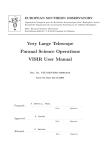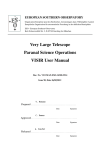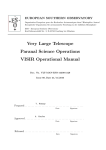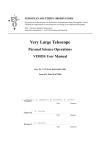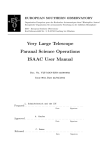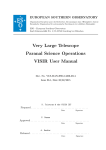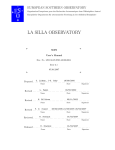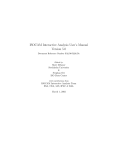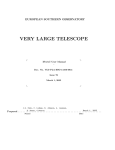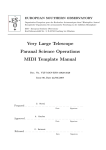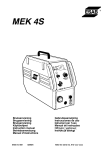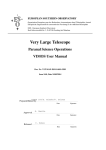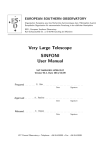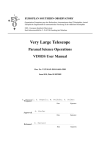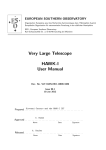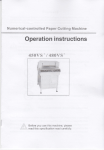Download VISIR USER MANUAL
Transcript
EUROPEAN SOUTHERN OBSERVATORY Organisation Européenne pour des Recherches Astronomiques dans l’Hémisphere Austral Europäische Organisation für astronomische Forschung in der südlichen Hemisphäre VERY LARGE TELESCOPE VISIR USER MANUAL Doc. No. VLT-MAN-ESO-14300-3514 Version 76.4 14/Jul/05 VISIR User Manual . Change Record Issue/Rev. Date Section/Parag. affected Reason/Initiation/Documents/Remarks 1.0 04/09/04 creation 1.1 10/12/04 2.4, 3.2, 6.2, 6.3, 7, 8 First release for science verification in P74 and OT proposals in P75. update for P75 Phase2 v76.1 01/02/05 all update for P76 CfP v76.2 06/07/05 all update for P76 Phase 2 v76.3 14/07/05 4.8.1 Corrected Legend Fig 17 v76.4 14/07/05 Cover pages Corrected typos v1.0, v1.1, v76.1: edited by R. Siebenmorgen, E. Pantin, M. Sterzik v76.2–4, updated by A. Smette. Send comments to [email protected] ii VISIR User Manual iii . Contents 1 Introduction 2 Observing in the MIR from 2.1 The Earth’s atmosphere . 2.2 The spatial resolution . . 2.3 MIR background . . . . . 2.4 Chopping and nodding . . 2.5 Sensitivity . . . . . . . . . 1 the ground . . . . . . . . . . . . . . . . . . . . . . . . . . . . . . . . . . . . . . . . . . . . . . . . . . . . . . . . . . . . . . . . . . . . . . . . . . . . . . . . . . . . . . . . . . . . . . . . . . . . . . . . . . . . . . . . . . . . . . . . . . . . . . . . . . . . . . . 1 1 1 2 2 3 3 Instrument description and offered observing modes 3.1 Imager . . . . . . . . . . . . . . . . . . . . . . . . . . . 3.2 Spectrometer . . . . . . . . . . . . . . . . . . . . . . . 3.3 Slit widths . . . . . . . . . . . . . . . . . . . . . . . . 3.4 Resolution . . . . . . . . . . . . . . . . . . . . . . . . . 3.5 Low resolution: offered central wavelengths . . . . . . 3.6 Calibration units . . . . . . . . . . . . . . . . . . . . . 3.7 Detectors . . . . . . . . . . . . . . . . . . . . . . . . . 3.8 Data acquisition system . . . . . . . . . . . . . . . . . . . . . . . . . . . . . . . . . . . . . . . . . . . . . . . . . . . . . . . . . . . . . . . . . . . . . . . . . . . . . . . . . . . . . . . . . . . . . . . . . . . . . . . . . . . . . . . . . . . . . . . . . . . . . . . . . . . . . . . . . . . . . . . . . . . . . . . . . . . . . . . . . 6 6 9 9 10 10 10 12 13 4 Observing with VISIR at the VLT 4.1 Proposal preparation . . . . . . . . . . . . 4.2 Telescope observing parameters . . . . . . 4.2.1 Instrument orientation on the sky 4.2.2 Chopping parameters . . . . . . . 4.2.3 Nodding parameters . . . . . . . . 4.3 Target acquisition . . . . . . . . . . . . . 4.4 Guide stars . . . . . . . . . . . . . . . . . 4.5 Brightness limitations . . . . . . . . . . . 4.6 Overheads . . . . . . . . . . . . . . . . . . 4.7 Calibration observations . . . . . . . . . . 4.8 Known problems . . . . . . . . . . . . . . 4.8.1 Decreased image quality . . . . . . 4.8.2 Low–level stripes . . . . . . . . . . 4.8.3 Bad residuals . . . . . . . . . . . . 4.8.4 Residuals of sky emission lines . . 4.8.5 Fringes . . . . . . . . . . . . . . . . . . . . . . . . . . . . . . . . . . . . . . . . . . . . . . . . . . . . . . . . . . . . . . . . . . . . . . . . . . . . . . . . . . . . . . . . . . . . . . . . . . . . . . . . . . . . . . . . . . . . . . . . . . . . . . . . . . . . . . . . . . . . . . . . . . . . . . . . . . . . . . . . . . . . . . . . . . . . . . . . . . . . . . . . . . . . . . . . . . . . . . . . . . . . . . . . . . . . . . . . . . . . . . . . . . . . . . . . . . . . . . . . . . . . . . . . . . . . . . . . . . . . . . . . . . . . . . . . . . . . . . . . . . . . . . . . . . . . . . . . . . . . . . . 17 17 17 17 18 19 19 21 21 21 21 22 22 23 23 23 24 5 VISIR data 5.1 Data format . . . . . . . . . . . . . . . . . . . . . . . . . . . . . . . . . . . . . . . . . . 5.2 Pipeline . . . . . . . . . . . . . . . . . . . . . . . . . . . . . . . . . . . . . . . . . . . . 5.3 VISIR spectrometer data . . . . . . . . . . . . . . . . . . . . . . . . . . . . . . . . . . 24 24 24 25 6 VISIR templates description 6.1 Acquisition . . . . . . . . . . . . 6.2 Observing with the imager . . . . 6.3 Observing with the spectrometer 6.4 Calibration . . . . . . . . . . . . 27 27 27 29 29 7 Checklist for Phase 2 preparation . . . . . . . . . . . . . . . . . . . . . . . . . . . . . . . . . . . . . . . . . . . . . . . . . . . . . . . . . . . . . . . . . . . . . . . . . . . . . . . . . . . . . . . . . . . . . . . . . . . . . . . . . . . . . . . . . . . . . . . . . . . . . . . . . . . . . . . . . . . . . . . . . . . . . . . . . . . . . . . . . . . . . . . . . . . . . . . . . . . . . . . . . . . . . . . . . . . . . . . . . . . . . . . . . . . . . . . . . . . . . . . . . . . . . . . . . . . . . . . . . . . . . . . . . . . . . . . . . . . . . . . . . . . 30 VISIR User Manual 8 Appendix: VISIR template 8.1 Acquisition . . . . . . . . 8.2 Observation . . . . . . . . 8.3 Calibration . . . . . . . . . parameters . . . . . . . . . . . . . . . . . . . . . . . . . . . . . . . . . . . . . . . . . . . . . . . . . . . . . . . . . . . . . . . . . . . . . . . . . . . . . . . . . . . . . . . . . . . . . . . . . . . . . . 9 Appendix: Filter transmission curves iv 31 31 33 35 37 VISIR User Manual . List of acronyms BIB BLIP BOB DIT ETC FWHM ICS IR IRACE MIR OB P2PP PAE pfov PSF S/N UT VISIR TCS TMA WCU Blocked impurity band Background limited performance Broker of observation blocks Detector integration time Exposure time calculator Full width at half maximum Instrument control software Infrared Infrared array control electronics Mid infrared Observing block Phase 2 proposal preparation Preliminary acceptance in Europe pixel field of view Point spread function Signal–to–noise ratio Unit telescope VLT imager and spectrometer for the mid infrared Telescope control system Three mirrors anastigmatic Warm calibration unit v VISIR User Manual 1 . 1 Introduction The VLT spectrometer and imager for the mid–infrared (VISIR), built by CEA/DAPNIA/SAP and NFRA/ASTRON, provides diffraction–limited imaging at high sensitivity in two mid-infrared (MIR) atmospheric windows: the N-band between ≈ 8 to 13 µm and the Q-band between 16.5 and 24.5 µm, respectively. In addition, it offers a slit spectrometer with a range of spectral resolutions between 150 and 30000. The MIR provides invaluable information about the warm dust and gas phase of the Universe. Micron sized particles such as silicates, silicon carbide, carbon, coals, aluminum oxides or polycyclic aromatic hydrocarbon (PAH) molecules are major contributors to the thermal MIR emission. The gaseous phase emits through a large number of ionic and atomic lines. Examples are NeII (12.8 µm ) and the pure rotation lines of molecular hydrogen at 8.02, 9.66, 12.27 and 17.03 µm . Because of the very high background from the ambient atmosphere and telescope, the sensitivity of ground–based MIR instruments cannot compete with that of space–born ones. However, ground based instruments mounted on large telescopes offer superior spatial resolution. For example VISIR at the VLT provides diffraction limited images at ∼ 0.300 (FWHM) in the N band. This is an order of magnitude better than what can be reached by the Spitzer Space Telescope (SST). The VISIR user manual is structured as follows: Basic observing techniques of ground–based MIR instruments are summarized in § 2. § 3 provides a technical description of VISIR and its offered observing modes offered. An overview on how to observe with VISIR at the VLT can be found in § 4. A description of the structure of the imaging and spectroscopic data files is given in § 5. A checklist to help the preparation of OBs is available in § 7. Acquisition, observing and calibration templates are explained in § 6. This manual reflects knowledge gathered during early phases of operations and is in some aspects to be considered to be preliminary. Therefore we strongly recommend to consult: http://www.eso.org/instruments/visir/ for additional information and updates. For support during proposal preparation and OB submission, please contact ESO’s User Support Department ([email protected]). 2 2.1 Observing in the MIR from the ground The Earth’s atmosphere Our atmosphere absorbs the majority of the MIR radiation from astronomical sources. The main absorbing molecules are H2 O, CH4 , CO2 , CO, O2 , O3 . However, the atmosphere is quite transparent in the two atmospheric windows: the N and Q band. They are centered around 10 and 20 µm, respectively. The transmission in the N band is fairly good at a dry site and becomes particular transparent in the wavelength range 10.5-12 µm . However, the transmission of the Q band is rapidly decreasing with wavelength and can be viewed as the superposition of many sub–bands having a typical spectral coverage of ∆λ = 1µm at an average transmission of 60%. Observations in this band require low water vapor content in the atmosphere. The atmospheric transmission in the N and Q bands is displayed on Fig. 1. 2.2 The spatial resolution The spatial resolution of an instrument is ultimately limited either by the diffraction of the telescope or the atmospheric seeing. The diffraction limit as measured by the diameter of the first Airy ring increases with wavelength as 1.22 λ/D, where λ is the observing wavelength and D the diameter of the telescope mirror (see solid line in Fig. 2). The wavelength dependence of the seeing can be derived by studying the spatial coherence radius of the atmosphere in the telescope beam and is to first order approximated by the Roddier formula, where the seeing is ∝ λ−0.2 (see dot-dashed lines in Fig. 2). VISIR User Manual . 2 Figure 1: MIR atmospheric transmission at Paranal computed with HITRAN for an altitude of 2600 m and 1.5 mm of precipitable water vapor at zenith. The US standard model atmosphere is used. However, initial results from VISIR data indicate that this formula overestimates the measured MIR seeing at Paranal by 20–50%, as the size of a UT mirror is comparable to the turbulence outer scale. As a result, VISIR data are already diffraction limited for optical seeing below 0.600 . 2.3 MIR background The atmosphere does not only absorb MIR photons coming from astrophysical targets, but also emits a strong background with the spectral shape of a black-body at about 253 K (Kirchhoff’s law). The telescope gives an additional MIR background. The VLT telescopes emits at 283 K with a preliminary emissivity estimate of < 15%. The VISIR instrument is cooled to avoid internal background contamination. The detectors are at ∼ 7 K and the interior of the cryostat at 33 K. The background radiation at 10µm is typically mN = −5 mag/arcsec2 (3700 Jy/arcsec2 ) and at 20µm mQ = −7.3 mag/arcsec2 (8300 Jy/arcsec2 ). Consequently, the number of photons reaching the detector is huge, often more than 108 photons/s. Therefore, the exposure time of an individual integration - the Detector Integration TIme (DIT) – is short, of the order of a few tens of milli–seconds in imaging mode. 2.4 Chopping and nodding The basic idea to suppress the MIR background is to perform differential observations, using the chopping/nodding technique. In the chopping technique two observations are performed. One set of exposures on–source, include the background and the astronomical source. A second set of off-source exposures measures the pure background. The on– and off–source observations have to be alternated at a rate faster than the rate of the background fluctuations. In practice, it is achieved by moving the secondary mirror of the telescope. For VISIR at Paranal, a chopping frequency of 0.25 Hz has been found to be adequate for Nband imaging observations, while 0.5 Hz are adopted for Q-band imaging. Spectroscopic observations are performed with lower chopper frequencies, at 0.1 Hz. VISIR User Manual . 3 Figure 2: VLT diffraction limit (full line) versus seeing. The Spitzer Space Telescope diffraction limits (dashed) are shown for comparison. The Roddier dependence is shown for two optical seeings (dashed-dot). The chopping technique cancels most of the background. However, the optical path is not exactly the same in both chopper positions. Therefore a residual background remains. It is varying at a time– scale which is long compared to that of the sky. This residual is suppressed by nodding, where the telescope itself is moved off–source and the same chopping observations as in the on–source position is repeated. An illustration of the chopping and nodding technique is shown on Fig. 3. Depending on the choice of chopping and nodding amplitudes and directions, up to 4 images of the source can be seen on the frame and used for scientific analysis. Of course, the free field–of–view on the chop/nod images can be severely reduced depending on the particular chopping and nodding parameters chosen. 2.5 Sensitivity Measurements of VISIR sensitivities are based on observations of mid–infrared calibration standard stars (Cohen et al. 1991, AJ 117, 1864). In imaging mode, the stars are recorded in the small field (0.07500 ) and intermediate field (0.12700 ) by perpendicular chopping and nodding patterns with amplitudes of 1000 . Calibrators are frequently observed during the night (§4.7). Flux and noise levels are extracted by multi–aperture photometry using the curve–of–growth method: the aperture used for all 4 beams in a given frame is the one for which the flux to noise ratio is the largest. By combining all 4 beams, the sensitivity in a given set–up (filter, field of view) is defined as the limiting flux of a point–source detected with a S/N of 10 in one hour of on–source integration. The growing calibration database allows a statistical analysis of the sensitivity with respect to instrumental and atmospherical conditions. The values for each filter given in Table 2 refer to the median of more than 600 different observations during September and December 2004. A graphical compilation is presented in Fig. 4 for the N-band and Q-band imaging filters. Some of the best measurements approach theoretical expectations, i.e. they are close to background limited performance (BLIP). Sensitivity estimates for the VISIR spectroscopy observing modes are obtained in a similar way. However, in this case, chopping and nodding are executed in parallel. Consequently, only 3 beams are VISIR User Manual . 4 Figure 3: Illustration of the chopping and nodding technique on observations of the blue compact galaxy He2-10. The galaxy only appears after chopping and nodding (courtesy VISIR commissioning team, June 2004). VISIR User Manual . 5 median small field sensitivity [mJy 10σ/h] 100 median intermed. field 10 ARIII PAH1 1 8 SIV SIV_1 9 PAH2 SIV_2 10 11 wavelength [µm] PAH2_2 SIC NEII NEII_1 12 NEII_2 13 median small field sensitivity [mJy 10σ/h] median intermed. field 100 10 Q1 17.0 17.5 Q2 18.0 18.5 19.0 wavelength [µm] Q3 19.5 20.0 Figure 4: Sensitivities for the VISIR imager for the N (top) and Q-band (bottom). Small and intermediate field observations are displaced for clarity. Background noise limits are indicated for the individual filter bandpasses. VISIR User Manual . 6 obtained, with the central one containing twice as much flux as the two other ones. Table 4 to 6 list typical sensitivities measured in low, medium and high resolution modes away from strong sky emission lines for the wavelength ranges offered in P76. Figure 5 shows the dependence of the sensitivity on wavelength. The median sensitivities are the reference for classification of VISIR service mode observations, and the basis to assess the feasibility of an observing programme. In particular, classifications of service mode OBs will be based on sensitivity measurements made at zenith. Calibrations will be provided following the guidelines given in § 4.7. For up to date information, please consult http://www.eso.org/instruments/visir. The use the VISIR exposure time calculator (ETC, located at http://www.eso.org/observing/etc/) is recommended to estimate the on–source integration time 1 . 3 Instrument description and offered observing modes For P76, VISIR offers two spatial scales in imaging and several spectral resolution modes in slit spectroscopy. The imager and spectrograph are two sub–instruments. They have independent light paths, optics and detectors. The cryogenic optical bench is enclosed in a vacuum vessel. The vessel is a cylinder, 1.2 m long and 1.5 m in diameter. Standard Gifford–McMahon closed–cycle coolers are used to maintain the required temperature: 33 K for most of the structure and optics and < 15 K for the parts near the detector. The detectors are cooled down to ∼ 7 K. 3.1 Imager The imager is based on an all–reflective design. The optical design is shown in Fig. 6. It consists of two parts: • A collimator, which provides an 18 mm diameter cold stop pupil in parallel light: As generally designed for IR instruments, the pupil of the telescope is imaged on a cold stop mask to avoid straylight and excessive background emission. The collimator mirror (M1) is a concave aspherical mirror. It is followed by a folding flat mirror (M2) which eases the mechanical implementation. • A set of three objectives mounted on a wheel. Each objective is based on a three mirror anastigmatic (TMA) system. Each of the TMA’s is made of three conic mirrors. The 0.07500 (small field, SF) and 0.12700 (intermediated field, IF) pixel scale are offered (Table 1). These offered pixel fields of view (pfov) ensure a proper sampling of the images in the N and Q-band. pfov fov diffractiona µm diffractiona pixels 0.12700 0.07500 32.500 × 32.500 19.200 × 19.200 94 159 1.88 3.18 a Radius of first Airy ring at λ=7.7µm Table 1: VISIR imager pixel scales offered. The pixel size of the DRS 256x256 detector is 50 µm . The first airy ring at λ=7.7µm corresponds to a radius of 0.2400 on the sky. The filter wheel is located just behind the cold stop pupil mask. The list of filters offered is given in Table 2. The transmission curves of the filters measured at 35 K are plotted in the Appendix. 1 Note that ETC v3.0.5 does not properly account for the background behavior as a function of airmass. Also, it does not take into account the airmass dependence of the seeing. VISIR User Manual . 7 sensitivity [mJy 10σ/1h] median best ever theoretical limit 100 8 sensitivity [mJy 10σ/1h] 10000 9 10 11 wavelength [µm] 12 13 model median 1000 12.70 12.75 12.80 12.85 wavelength [µm] 12.90 Figure 5: Sensitivity as a function of wavelength for low (top) and high (bottom) resolution mode. Four offered settings of the N-band low-resolution are stitched together. Atmospheric molecular absorption, e.g. at 9.55, 11.8 and 12.5 µm, is evident. Note the detector feature at 8.8 µm. Dots indicate individual observations, full lines represent median and the dashed line the best sensitivities. In the 12.81 µm region several settings of the high-resolution mode are shown. Theoretical model curves correspond to BLIP. VISIR User Manual . 8 entrance window diaphragm (focal plane) cold stop M2 detector TMA optics filter M1 Figure 6: The optical path of the imager in the intermediate field (0.12700 /pixel) is shown from the entrance window down to the detector. filter λc (µm ) half–band width (µm ) maximum transmission (%) PAH1 ArIII SIV 1 SIV SIV 2 PAH2 SiC PAH2 2 NeII 1 NeII NeII 2 Q1 Q2 Q3 8.59 8.99 9.821 10.49 10.771 11.25 11.85 11.881 12.271 12.81 13.04 17.65 18.72 19.50 0.42 0.14 0.18 0.16 0.19 0.59 2.34 0.37 0.18 0.21 0.22 0.83 0.88 0.40 77 72 72 70 70 75 75 58 51 64 68 59 49 50 sensitivity (mJy 10σ/1h) theory median (BLIP) SF IF 1.6 4.1 4.0 4.5 4.6 2.3 1.2 4.1 6.9 6.1 6.3 11.1 13.6 41.7 5 6 30 8 9 6 7 7 12 12 15 50 50 100 8 70 60 13 20 9 18 15 20 18 22 120 80 160 Table 2: VISIR imager filter characteristics, following the manufacturer specifications, except for the central wavelengths noted with 1 which were re-determined with a monochromator and the WCU because they deviate from specifications. The last 3 columns give, respectively, the theoretical expectations under BLIP and excellent weather conditions, and the measured median sensitivities for the Small and Intermediate Field obtained in various weather conditions. The measured sensitivities were obtained using the curve–of–growth method on data obtained in perpendicular chopping/nodding directions (4 beams). VISIR User Manual 3.2 . 9 Spectrometer VISIR offers slit spectroscopy at three spectral resolutions with a pixel scale of 0.12700 . This is obtained by means of two arms, one with low order gratings for the low and medium spectral resolution, the other with large echelle gratings providing high spectral resolution. Figure 7: Schematic layout of the design of the VISIR spectrometer. The long slits have a length of 32.500 and therefore cover the whole width of the detector. The short slits, only used in high–resolution, cross–dispersed mode, have a length of 4.100 . The all-reflective optical design of the spectrometer uses two TMA systems in double pass (pass 1: collimator, pass 2: camera). A schematic layout of the VISIR spectrometer design is shown in Fig. 7. The 3–mirror system of the low– and medium–resolution arm gives a 53 mm (diameter) collimated beam; the collimated beam diameter in the high-resolution arm is 125 mm. Both subsystems image the spectrum onto the same detector; selection between the two spectrometer arms is done by two pairs of folding flat mirrors. In front of the actual spectrometer subsystems is a reflective re–imager consisting of two off–axis paraboloids and three folding flats. The re–imager provides a 16 mm diameter cold-stop pupil in parallel light and transforms the incoming VLT Cassegrain beam of F:13.4 to an F:10 beam at the spectrometer entrance. The spectrometer slit wheel is also equipped with a very wide slit (15.300 ) named OPEN in P2PP. It gives the possibility to make imaging with the spectrometer detector and is used for object acquisition and centering on the detector. The list of available filters for spectroscopic acquisition offered is given in Table 3, together with their measured bandpasses and approximate sensitivities for image acquisition. 3.3 Slit widths Three different slit widths (0.400 , 0.7500 and 100 ) are offered for all settings. For over-sized widths (e.g. for the 100 slit with respect to the diffraction limit around 10µm ) the spectral resolution of a VISIR User Manual . filter λc (µm ) half–band width (µm ) sensitivity (mJy/10σ/1h) N SW N LW ArIII NeII 1 NeII 2 8.85 12.1 8.94 12.35 12.81 1.35 1.9 0.11 0.50 0.10 40 40 200 80 50 10 Table 3: VISIR spectrometer filter characteristics. The filters transmissions have been determined with a monochromator and the WCU. The last column list the measured median sensitivities which were obtained using the curve–of–growth method on data obtained in parallel chopping/nodding directions (3 beams). point–source spectrum is better than the one of the sky spectrum; in addition, the zero–point of the wavelength calibration will be affected by an incorrect centering of the object within the slit. 3.4 Resolution In the N band, the low–resolution and medium resolution modes provide spectral resolving power of ∼ 300 (Table 4) and ∼3000 (Table 5), respectively. In high resolution long–slit mode, narrow wavelength ranges around the 8.02 [H2 S4], 12.813 [Ne II] and 17.03 µm [H2 S1] line are offered. With the 100 slit the measured spectral resolution is R ∼ 15000 (Table 6), and a minimum flux in the line below 10−16 W/m2 /arcsec2 can be achieved. This value corresponds to an approximate sensitivity limit around 1 Jy in the continuum. A high–resolution, cross–dispersed mode with a 400 short slit is available for wavelength settings around 9.66 [H2 S3] and 12.27 µm [H2 S2]. Please consult http://www.eso.org/instruments/visir for the latest update of the list of offered modes and slits. 3.5 Low resolution: offered central wavelengths In addition to the 4 central wavelengths (8.8, 9.8, 11.4 and 12.4 µm ) announced in Phase 1, two additional ones are offered for Phase 2, at 8.5 and 12.2 µm . The main reason justifying these two new settings is of cosmetic nature. As described below, the detector has a number of ‘bad’ pixels. In particular, some of them, mainly located at the bottom left of the detector appear to cause particularly severe striping in the chopped images if their illumination is slightly different in the two chopping positions. This situation can be produced either if one of the beams of a bright object falls on these pixels or because of a residual scanner jitter of the grating units. The 8.5µm setting moves the blue wing of the ozone band off the wavelength range covered by the detector, at the expense of having a larger part of the detector covering the red wing of the water-vapour band. The 12.2µm setting avoids the CO2 band 3.6 Calibration units A warm calibration unit (WCU) is located on top of the VISIR vacuum enclosure. The WCU is also called star simulator. It simulates either a monochromatic point source with adjustable wavelength or an extended black-body source with adjustable temperature. A selection mirror allows to switch from the telescope to the simulator beam. It can be used for calibration and tests, also during daytime. Fig. 8 shows the unit on top of the enclosure. VISIR User Manual 11 . λ – range (µm ) λc (µm ) grating order 7.7-9.3 8.0-9.6 9.0-10.6 10.34-12.46 11.14-13.26 11.34-13.46 8.5 8.8 9.8 11.4 12.2 12.4 2 2 2 1 1 1 spect.–resol. (measured, 100 slit) 300 300 305 185 215 215 – – – – – – 390 390 360 220 250 250 dispersion (pixels/µm ) 160.01 160.02 160.05 119.94 119.96 119.96 Table 4: VISIR low resolution offered settings. The first column gives the wavelength range of a spectrum for the central wavelength (λc ) listed in the 2nd column. The measured sensitivities are ∼ 50 mJy at 10σ/1h in the clean regions of the spectrum (cf. Fig. 5) for a slit width of 100 . Offered slits have widths of 0.40, 0.75 and 1.0000 . The spectral resolution of the 8.5µm and 12.2µm settings has not been independently measured; values for the 8.8µm and 12.4µm settings are reported instead. λ – range (µm ) λc (µm ) grating order spect.–resol. (measured, 100 slit) dispersion (pixels/µm ) 8.706-8.893 11.274-11.526 8.8 11.4 2 1 ∼ 3500 ∼ 1800 1367.43 1011.2 Table 5: VISIR medium resolution setting. The measured sensitivities are ∼ 200 mJy at 10σ/1h. Offered slits have widths of 0.40, 0.75 and 1.0000 . mode λc (µm ) ∆λ (µm ) line order spect.–resol. (theoretical) dispersion (pixels/µm ) sensitivity Jy 10σ/1h HR HR HR 7.970 – 8.270 12.738 – 12.882 16.800 – 17.200 0.02420 0.03571 0.05156 [H2 S4] [Ne II] [H2 S1] 17B 11A 8B 32000 17000 14000 10544 7145 4950 ∼3 ∼0.9 <10 HRX HRX 9.360 – 9.690 12.210 – 12.760 0.02325 0.03864 [H2 S3] [H2 S2] 15A 11B 25000 20000 10974 6604 ∼5 ∼1.5 Table 6: VISIR high resolution long–slit (HR) and cross-dispersed (HRX) modes. The second column gives the minimum and maximum allowed values for the central wavelength (λc ) in the given setting. The wavelength range per setting in given in the 3rd column (∆λ). Offered slits have widths of 0.40, 0.75 and 1.0000 . VISIR User Manual . 12 Figure 8: Schematic drawing of the warm calibration unit on top of the VISIR vessel. 3.7 Detectors The VISIR imager and spectrometer are each equipped with a DRS, former Boeing, 256 × 256 BIB detector. The quantum efficiency of the detectors is greater than 50% and reaches 65% or more at 12 µm (Fig. 9). The detector noise has to be compared with the photon noise of the background. As shown in Fig. 10, the measured noise in an observation consists of read–out noise and fixed pattern noise, which are both independent of the detector integration time (DIT). At the operating temperature of the detector (∼ 7 K), the dark current, which is the signal obtained when the detector receives no photons, is negligible compared to the background generated by the photons emitted by the telescope and the atmosphere. The dark current is removed by the observation technique (chopping or nodding). It is at least 6 times lower than the photon noise for the spectrometer and negligible for the imager. The detectors have a switchable pixel (“well”) capacity. The large capacity is used for broad-band imaging and the small capacity for narrow band imaging and spectroscopy. Detector saturation due to the enormous MIR background is avoided by a storage capacity of 1.9 · 106 e− in small and 1.8 · 107 e− in large capacity modes, respectively. For background limited noise performance (BLIP), the optimal operational range of the detector is half of the dynamic range for the large capacity, and between 1/2 and 1/5 for the small capacity. The detector is linear over 2/3 of its dynamic range (Fig. 11) and its working point is set in the middle of the dynamic range. During commissioning it was found that, for about half of the array, the gain does not differ by more than 2% peak-to-peak. By comparison with other limitations, flat-field corrections, which are difficult to implement in the MIR, are not considered important. The detector integration time (DIT) is a few milli–seconds in broad-band imaging and may increase to ∼ 2 s in high resolution spectroscopy. The DIT is determined by the instrument software according to the filter and pfov. It is not a parameter to be chosen by the observer. The DRS detectors contain a fair fraction of bad pixels (< 2%, Fig.12). The imager detector also suffers from striping and appearances of ghosts. The relatively wide rectangular area in the lower right corner (South–West corner for PA = 0 deg) of the imager detector or some other rectangular areas are masked out to avoid such disturbances (Fig. 13). For bright objects the DRS detector shows VISIR User Manual . 13 Figure 9: Detector quantum efficiency at 12 K provided by DRS (solid line). The same curve (dashed) but scaled by 0.72 reflects a lower limit of the quantum efficiency. The scaling was derived from laboratory measurements. Note the sharp absorption feature at 8.8 µm that will appear in raw spectroscopic data. Figure 10: Noise as a function of the incoming flux in the large (left) and small (right) capacity mode. Superimposed is the theoretical photon noise. BLIP performances are approached for higher fluxes and larger DIT, respectively. memory effects. Stabilization is ensured by introducing dead times where necessary. It is advised to observe only sources fainter than 500 Jy in N and 2500 Jy in Q. These artifacts are less important in spectroscopy due to the lower light levels but clearly visible on objects brighter than ∼ 2% of the background. However, a TEL.CHOP.THROW between 9 to 1300 shoud be avoided, in particular for objects bright enough to be seen in individual DITs, as one of the beams will hit some particularly hot pixels in the lower–left of the spectrometer detector (see Fig.14). 3.8 Data acquisition system Both VISIR detectors are controlled by the ESO standard IRACE acquisition system. In imaging the read–out rate of the detector is high. Up to 200 frames per s are read for a minimum detector integration time of DIT= 5 ms. Such a frame rate is too high to store all exposures. One VISIR image is of size 256x256; each pixel is coded with 4 bytes (long integer). Thus one read–out has a size of 262 kB. During each chopping cycle the elementary exposures are added in real time and only the result is stored on disk. At a chopping frequency of fchop = 0.25 Hz every Tchop = 4 s one VISIR VISIR User Manual . 14 Figure 11: Linearity curve of the detector in the large (left) and small (right) capacity modes. The break in the response at ≈ 2/3 at 1.8 · 107 e− of the large and at 1.9 · 106 e− of the small capacity are indicated by full lines. The top lines indicate the well capacities. Figure 12: Bad pixel maps of the imager (left) and spectrometer (right) detectors. The large grey rectangular areas correspond to electronically masked pixels in order to decrease detector striping. VISIR User Manual . 15 Figure 13: The DRS detector shows stripes and repeating ghosts for very bright sources (left). The ghosts are distributed every 16 columns. For other sources striping is not apparent (right). ; ; ; Figure 14: Sequence of chop/nod, reduced spectra obtained in the Medium Resolution mode with a central wavelength = 8.8µm . The TEL.CHOP.THROW = 8, 11, 13 and 1400 from left to right. Note the presence of significant striping when the ‘left’ beam hits some hot pixels at the lower left of the detector. For the location of the object along the slit (pixel X=123 at row Y = 128), this occured for TEL.CHOP.THROW between 10 and 1300 , approximatively. The horizontal lines at the middle of the images are caused by the lack of detector response at 8.8µm . VISIR User Manual . 16 image is stored as a plane in a data cube of a FITS file. The number of chopping cycles corresponds to the time spent in one nodding position, Tnod . This nodding period is typically Tnod = 90 s for science observations. The chopper frequency, DIT and also Tnod are predefined by the system. The number of saved A–B frames in one FITS file is: Ncycl chop = Tnod /Tchop (1) The number of nodding cycles is computed from the total integration time as given by the observer. The total number of stacked images for each secondary position, respectively chopper half cycle, is NDIT. This parameter is computed according to: NDIT = (2 · DIT · fchop )−1 − NDITSKIP (2) and is given by the system. It depends on DIT, chopping frequency and NDITSKIP: some read–outs at the beginning of each chopper half cycle are rejected during stabilization of the secondary. Typical stabilization times of the secondary are 25 ms. The number of rejected exposures is given by NDITSKIP. Similar, during stabilization after each telescope movement, respectively nodding position, a number NCYSKIP of chopping cycles is ignored. The timing organization of data is shown in Fig. 15. The total on source integration time is: tsource = 4 · Ncycl nod · Ncycl chop · NDIT · DIT (3) The total rejected time is: tskip = 4 · Ncycl chop · DIT · (NDITSKIP · Ncycl nod + NDIT · NCYSKIP) (4) and the total observing time is: ttot = tsource + tskip (5) Typical duty cycles (tsource /ttot ) are about 70%. NCYSKIP N_cycl_chop NCYSKIP N_cycl_chop An Bn Bn An T_nod NDIT NDITSKIP NDITSKIP DIT Ac Bc Ac Bc T_chop Figure 15: Data timing in VISIR. Ac and Bc refer to the two chopper positions, An and Bn refer to the two nodding (telescope) positions. Note the AnBnBnAn cycle sequence for the nodding to save observing time. VISIR User Manual 4 . 17 Observing with VISIR at the VLT 4.1 Proposal preparation Tools are available to prepare the observations, either during phase 1 (call for proposals), or during phase 2 (creation of observing blocks by the observer): • The exposure time calculator (ETC available at http://www.eso.org/observing/etc/) may be used to estimate the integration time needed to obtain the required S/N for a given instrument setting; because of the numerous sky absorption lines and the detector feature (see Fig. 5), it is recommended to display the S/N as a function of wavelength when using the spectrograph ETC; • As for all VLT instruments, astronomers with granted VISIR telescope time prepare their observations using the phase 2 proposal preparation tool (P2PP), described at http://www.eso.org/observing/p2pp/P2PP-tool.html. Acquisitions, observations and calibrations are coded via observing templates. One or more templates build up an observing block (OB). They contain all the information necessary for the execution of a complete observing sequence. An overview of the available VISIR templates and their parameters is given in §6 of this manual. • For each science template, the user has to provide a finding chart so that the target can be acquired. In addition to the general instruction on how to create these finding charts, see http://www.eso.org/observing/p2pp/ServiceMode.html, the following VISIR requirements apply: – All finding charts have to be made using existing infrared (K-band or longer wavelength) images. Typically, 2MASS or DENIS K-band images are acceptable, although higher spatial resolution may be preferable. – If the wavelength at which the finding chart has been taken is different from that of the science observation, e.g. a K–band finding chart for a 10µm spectroscopic template, the user has to describe clearly how to identify the target at the observing wavelength in the README section of the programme description. Adequate examples of such comments are: ∗ The target will be the brightest source in the field of view at 10µm . ∗ At 10µm , there will be two bright sources in our field of view. The science target is the southernmost of these two. Note that observations close to zenith during meridian crossing should be avoided, because of fast tracking speeds that do not allow proper background cancelation after nodding. Questions related to the VISIR Phase1 and Phase 2 observing preparation should be directed to the User Support Department ([email protected]). 4.2 4.2.1 Telescope observing parameters Instrument orientation on the sky By default, the imager orientation is such that North is at the top and East is to the left. For the spectrometer, the default orientation is rotated by 90◦ respective to the imager, so that the North is to the left and the East to the bottom, with the slit orientation along the North-South direction. Since VISIR is mounted on a rotator at the Cassegrain focus of Melipal, it is possible to change the default orientation of VISIR on the sky, for example, to obtain the spectra of two objects at once. The parameter TEL.ROT.OFFANGLE, defaulted to 0◦ , is used for this purpose. If P A represents the VISIR User Manual . 18 required position angle on the sky east of north (i.e., counted positively from north to east) within the range 0 to 360◦ , then TEL.ROT.OFFANGLE = 360 − PA . 4.2.2 Chopping parameters The chopping technique, as described in § 2, is based on beam switching using the moving secondary mirror of the telescope. It allows to alternatively observe a field, then another field offset from the first by a chopping distance or throw, called TEL.CHOP.THROW, see Fig. 16. This parameter can be set by the user. To avoid chopping inside the object it is recommended to use a chopping and nodding throw which is ∼ 1.5 times larger than the estimated MIR diameter of the object. In the case of point sources, the throw is usually set around ∼1000 to ensure proper separation of the different beams. The maximum chopping throw at the VLT is 3000 and the minimum is 800 . For good image quality, and good background cancelation, chopping and nodding throws below 1500 are recommended (see § 4.8.1). Note that for chopping throws larger than the field-of-view, the negative beams will not be seen on the detector, and the integration times have to be adjusted accordingly. The chopper position angle, TEL.CHOP.POSANG, is the angle of chopping counted East of North (see Fig. 16)2 . This parameter can be set by the observer. In order to keep the same distribution of beams on the detector for a different rotator angle (TEL.ROT.OFFANGLE) as in the default rotator position, then TEL.CHOP.POSANG must be equal to TEL.ROT.OFFANGLE. In particular, this is the case in spectroscopy if the observer wishes to have the 3 beams along the slit. As stated in Sect 3.5, the chopping frequency is not a parameter accessible to the observer, it is fixed internally to ensure the best data quality. North −− n itio Pos le ang ow hr rt pe op Ch Pointing position East + Figure 16: Definition of chopping parameters from the telescope point–of-view. If the position angle (P A) is measured counter–clockwise from North to East with PA between 0 and 360◦ , then TEL.CHOP.POSANG is 360◦ − P A. The positive beam (+) is obtained when the M2 is at Chopping Position A and corresponds to the pointing position of the telescope as given in the FITS header. The negative beam (-) is obtained by moving the M2 so that it points to a position angle on the sky given by PA and a throw of TEL.CHOP.THROW from the telescope pointing position (Chopping Position B). If TEL.CHOP.POSANG = TEL.ROT.OFFANGLE = 360◦ - PA, the resulting image on the detector will appear as in one of the nodding position images illustrated in Fig. 19. 2 In practice, the telescope is actually given an offset equal to TEL.CHOP.THROW/2 along the angle given by PA. Relative to its idle position and looking from the M1 to the sky, the M2 oscillates along PA between two positions given by ± TEL.CHOP.THROW/2. This is completely transparent to the user. VISIR User Manual 4.2.3 . 19 Nodding parameters The nodding technique allows to switch from one field to another by offsetting the telescope by several tens of arc–seconds. It allows to correct for optical path residuals that remain after chopping (§ 2). The nodding period is 90 s for exposure time equal or longer than 180s, or is half this value for shorter exposure times. This parameter can only be modified by the instrument operator. In all the ’AutoChopNod’ templates, the nodding offset is equal to TEL.CHOP.THROW and cannot be modified. In order to reach Nodding Position B, the telescope executes an offset of TEL.CHOP.THROW, along a position angle equal to • PA + 90◦ = 360◦ - TEL.CHOP.POSANG + 90◦ , if SEQ.CHOPNOD.DIR = PERPENDICULAR, • PA + 180◦ = 180◦ - TEL.CHOP.POSANG, if SEQ.CHOPNOD.DIR = PARALLEL. The resulting distribution of images on a frame is illustrated in Fig.19. In imaging, more flexibility on the nodding offsets are possible with the VISIR img obs GenericChopNod template. 4.3 Target acquisition Observing blocks must start with an acquisition template. Pointing to a target can only be performed through an acquisition template. Target coordinate, name and proper motion are all set in the acquisition templates. The execution of the acquisition templates presets the telescope to the target coordinate given by TEL.TARG.ALPHA and TEL.TARG.DELTA. Offsets with respect to the target coordinates can be specified by TEL.TARG.OFFSETALPHA and TEL.TARG.OFFSETDELTA and allow, for example, to use a bright offset star for precise acquisition. To guarantee proper centering within the slit when using an offset star, the angular separation between the offset star and the target should not be larger than 6000 . Acquisition with an offset star has not been tested with the narrow, 0.400 slit and should be avoided in P76. Note that the convention TEL.TARG.ALPHA + TEL.TARG.OFFSETALPHA = RA(offsetstar) TEL.TARG.DELTA + TEL.TARG.OFFSETADELTA = DEC(offsetstar) 3 is used . The target can be further offset to a particular position on the detector or in the slit by manual intervention by the operator. There are two acquisition templates for imaging, VISIR img acq Preset, VISIR img acq MoveToPixel and one for spectroscopy, VISIR spec acq MoveToSlit. The observing parameters are described in § 8.1. The effect of all acquisition templates is first to point the telescope so that the center of the detector match the target coordinates entered by the user, within the accuracy of the VLT pointing (see below). For VISIR spec acq MoveToSlit, the first acquisition images are obtained with the OPEN (15.300 ) slit. Then, • Both VISIR img acq MoveToPixel and VISIR spec acq MoveToSlit requires interaction with the instrument operator or night support astronomer in order to center the target at the appropriate location on the detector. Without further indication given by the observer, the default locations are: – the center of the detector, for VISIR img acq MoveToPixel and SEQ.CHOPNOD.DIR = PARALLEL; 3 This convention is identical to the UVES one, but differs, from example, from the ISAAC or NACO one. VISIR User Manual . 20 – in the top left quadrant of the detector, at a distance equal to TEL.CHOP.THROW/2 from the center of the detector in both X and Y, for VISIR img acq MoveToPixel and SEQ.CHOPNOD.DIR = PERPENDICULAR; – at the center of the chosen slit, for VISIR spec acq MoveToSlit. In service mode, acquisition with these templates are limited to objects brighter than 0.2 Jy. This limit is particularly constraining for VISIR spectroscopic observations. All acquisition images are recorded and archived. As part of the execution of the VISIR spec acq MoveToSlit template, an image used to measure the slit location is always taken and archived. In service mode, through slit images are also taken and archived so that the user can assess the correct centering of her/his object. The slit location image and the through–slit images are automatic procedures that cannot be modified by a service mode observer. Their execution time is included in the advertised execution time of the spectroscopic acquisition template. • If the target coordinates are well known, VISIR imaging modes allow to perform blind preset observations with the VISIR img acq Preset template. In this case, no acquisition images are taken. The target will be located at the center of the detector with an accuracy limited by the accuracy of the guide star (typically 1 00 RMS). If both the target coordinates and the guide star ones are within the same astrometric systems, the pointing accuracy is limited by the relative accuracy between the coordinates of the two objects. In particular, the pointing accuracy maybe affected by significant (usually unknown) proper motion of the guide star. Note that the observatory does not guarantee the accuracy of the world coordinate systems (WCS) keywords in the FITS headers. For a successful completion of an OB, the observer has to ensure that correct target coordinates are provided for the equinox J2000.0 ideally at the epoch of the observations4 . The following cases require special care: • imaging in the small field: in some conditions, an error of less than 1000 on the coordinates can bring the target outside of the field; • spectroscopic acquisition: in some conditions, an error of less than 7.500 on the coordinates can bring the target outside of the wide slit used. Errors of such scale are common in the following situations: • high proper-motion stars: in particular, if the epoch of the VISIR observations is significantly different from the epoch for which the coordinates were determined. • point-like sources within extended objects: such as an AGN: a number of catalogues do not provide accurate coordinates of the nucleus. Coordinates given by 2MASS are more reliable. • coordinates obtained with low spatial resolution instrument, such as MSX, etc... For solar system objects, the J2000.0 equinox, topocentric, ICRF or FK5 coordinates at the epoch of the observations are required, as the Telescope Control System takes into account precession, nutation, annual aberration and refraction. On the contrary, the topocentric, apparent coordinates at the observatory, often used in other observatories, should not be used. Additional velocity parameters corresponding to µ(α) cos δ and µ(δ) must be given in 00 /s. 4 In particular, note that P2PP only accepts coordinates for J2000.0. Entries for equinox and proper motions are not (yet) taken into account. VISIR User Manual 4.4 . 21 Guide stars Guide stars are mandatory for active optics and field stabilization. Any VLT programme should make sure that a guide star (USNO catalog) with a V = 11 − 13 mag is available within a field of 8’ around the object. If TEL.AG.GUIDESTAR is ’CATALOGUE’, a guide stars from the guide star catalog will be automatically selected by the TCS. If TEL.AG.GUIDESTAR is ’SETUPFILE’, the observer has to provide the coordinates of the GS. The coordinates of the guide star also fix the reference point for the World Coordinate System coordinates, that appear in the FITS header of the files. In both cases, the telescope operator acknowledges the guide star. Depending on the weather conditions or if the star appears double in the guide probe, the telescope operator may have to select another guide star. Therefore, If the observer has selected a guide star for astrometric purposes – for example, to insure the repeatability of the pointings between different OBs –, a clear note should be given in the README file, for service mode observations, or be specifically mentioned to the night time astronomer, in visitor mode. As stated above, the observatory does not guarantee the accuracy of the world coordinate systems (WCS) keywords in the FITS headers. 4.5 Brightness limitations There are currently no brightness limitations with VISIR. However, it is advised to observe only sources fainter than 500 Jy in N and 2500 Jy in Q to avoid detector artifacts (§ 3.7). 4.6 Overheads The VLT telescope overhead for one OB which includes active optics setting, selection of guide star, field stabilization is 6 min. VISIR instrument configurations can be changed in a short time. For example a complete change of instrument settings takes less than 2 minutes. The total time for an image acquisition of a bright sources (> 1 Jy) takes ∼ 5 min. for one fine acquisition iteration, or in blind preset 2 min. Spectroscopic acquisitions take longer and are strongly dependent on the source brightness : an overhead of 15 min. is accounted for sources > 1 Jy, while 30 min. are required for sources between 0.2 and 1 Jy, respectively. Instrument overheads due to chopping and nodding duty cycle losses have been measured to be 25% of the observing time for the imager and 50% for the spectrometer, respectively. The total observing time requested by the observer must include telescope and instrument overheads. 4.7 Calibration observations MIR observations depend strongly on the ambient conditions such as humidity, temperature or airmass. In service mode science observations are interlace by calibration observations on a timescale of 3h. Observations of photometric standards will be provided by the observatory within a time interval of three hours w.r.t. the science observations. Calibrators, unless provided by the observer, are selected from the MIR spectro–photometric standard star catalog of the VLT (http://www.eso.org/instruments/visir). This catalog is based on the radiometric all–sky network of absolutely calibrated stellar spectra by Cohen et al.5 . This list is supplemented by MIR standards used by TIMMI26 . 5 Cohen et al., 1999, AJ 117, 1864 6 http://www.ls.eso.org/lasilla/sciops/3p6/timmi/html/stand.html VISIR User Manual . 22 At present the standard star catalog contains 425 sources. Zero point fluxes (Jy) have been calculated for the VISIR filter set by taking into account the measured transmission curves (Fig. 21), the detector efficiency (Fig. 9) and an atmosphere model (Fig. 1). A PSF can be derived from these photometric standard star observations. However, it is not guaranteed that the accuracy is sufficient for deconvolution purposes. If the observer requires a specific PSF measurement, (s)he has to provide the corresponding PSF OB. Observations of photometric standards provided by the observatory are taken using the VISIR img cal AutoChopNod template (§ 6) with the following settings: SEQ.TIME TEL.CHOP.POSANG TEL.CHOP.THROW SEQ.CHOPNOD.DIR 180 sec for N and 360 sec for Q band 0◦ 1000 PERPENDICULAR Filter INS.FILT1.NAME and pixel scale INS.PFOV will be set according to the science observations. In spectroscopy, the observatory will provide spectro–photometric observations of a telluric (K type) standard star in the Low Resolution mode, based on the same catalog as for imaging with an airmass difference no larger than 0.2 AM. Such a calibration measurement will be performed at least once per night, per instrument configuration. More precisely the following settings of the VISIR spec cal LRAutoChopNod template (§ 6) will be used: SEQ.TIME TEL.CHOP.POSANG TEL.CHOP.THROW SEQ.CHOPNOD.DIR 180 sec 0◦ 800 PARALLEL The wavelength setting INS.GRAT1.WLEN and INS.SLIT1.WIDTH will be adjusted to the science observation. Important note: The observatory does not provide standard calibrations for VISIR medium and high resolution spectroscopy. Thus for medium and high resolution mode the observer has to supply his own calibration by supplying a calibration OB to each science OB. The observing time needed to execute this calibration is charged to the observer. Ideally, early type stars should be chosen. For both imaing and spectroscopy, day calibrations of VISIR are performed with an extended source that mimics a black–body with adjustable flux (by regulating its temperature). For each instrument mode, a corresponding flat–field is recorded, which consists of a series of images with different background levels. Bad pixels, gain maps and fringing patterns can, in principle, be derived from these flat-fields. However, at the moment, the scientific value of the application of these corrections is not established. Day calibrations are supplied to the user on an experimental basis. 4.8 Known problems In addition to effects caused by the cosmetic quality of the detectors mentioned above (§ 3.7), the following problems may affect the quality of the observations. 4.8.1 Decreased image quality The image quality can be severely degraded in observations obtained with a large (> 1500 ) chopper throw, as can be seen in Fig.17. The origin of this problem has been localized and all efforts will be made to implement a solution as soon as possible. VISIR User Manual ESO STD . r.VISIR.2005−01−29T03:48:24.517_tpl_0000.fits 05:25:02.052 −10:19:44.00 2000 smette/Skycat Apr 17, 2005 at 20:08:18 ESO STD smette/Skycat 23 r.VISIR.2005−01−29T03:48:24.517_tpl_0000.fits 05:25:02.052 −10:19:44.00 2000 Apr 17, 2005 at 20:09:01 Figure 17: Image of a star obtained in the PAH1 filter in the Small Field (0.07500 /pixel), and with TEL.CHOP.THROW = 25 00 , SEQ.CHOPNOD.DIR = PARALLEL and TEL.CHOP.POSANG = 90◦ . Left: the core of the star image appears double with two peaks separated by ≈ 0.200 . Right: the wings of the image reveals 2 additional components on both sides of the core, separated by 1.800 and containing ≈ 4% of the total flux. Note also the electronic ghosts that appear as white features immediately above and below the core, and which only affect bright sources. 4.8.2 Low–level stripes The background level of individual DIT images fluctuates not only with the varying sky background but also with the detector temperature. The latter follows the 1Hz period of the closed–cycle cryo– cooler. The mean background level in two consecutive half–cycle frames (corresponding to the two chopper positions) may therefore not be equal. If this difference is larger than a few tens of ADUs, structures in the gain maps will appear as low–level stripes. Such stripes tend to smooth out on long integrations. 4.8.3 Bad residuals The chopping and nodding technique does not always lead to a satisfactory removal of all the structures seen in individual images. Bad residuals have been found to occur in the following situations: • in observations carried out close to zenith and, to a lesser extent, close to the meridian in general: the likely cause is the fast rotation of the field relative to the telescope structure; • in variable atmospheric conditions. In addition, it seems that imaging of extended objects are also more likely to be affected by low–level bad residuals, similar to fringes in some aspects, whose orientation on the images changes at the same angular velocity as the rotator. The origin of these structures is not understood. 4.8.4 Residuals of sky emission lines In spectroscopy, the scanners of the grating units may still show a small residual motion at the beginning of an exposure, or, mainly for the HR or HRX modes, show some jitter after a nodding offset. The first few frames at a given wavelength setting may therefore show stronger than expected residuals at the wavelength of the sky emission lines (more exactly, of the wings of sky emission lines). For the HR and HRX modes, the residuals of the scanner jitter tend to cancel out on long integrations, and lead to a very slight decrease of the spectral resolution. VISIR User Manual 4.8.5 . 24 Fringes The DRS detector shows fringes which are generated in the detector substrate. One example of such fringes is shown in Fig. 18 for the medium–resolution mode. The fringes are stable and are not apparent in chopped images, but the spectra are modulated. Division of the extracted spectra by standard star spectra simultaneously removes most of the fringes and corrects for telluric features. Figure 18: VISIR spectrum in staring, medium–resolution mode showing the detector fringing (white). The detector absorption feature at 8.8 µm is visible as black horizontal bar (cf. Fig. 9). Dark vertical stripes are caused by the non–uniform gain of the different electronic amplifiers. These features are largely removed by chopping. 5 VISIR data 5.1 Data format One FITS file is saved for each telescope nodding position. This file is a data cube and contains for each chopping cycle: 1. half cycle frames of the on–source position (A) of the chopper, 2. the average of the current and all previous(A–B) chopped frames, In addition, the last plane of the cube contains the average of all chopped frames. For the default value of the rotator angle (0◦), images are oriented North up and East left. Spectroscopic data are aligned horizontally in the spatial and vertically in the dispersion direction (cf. Fig.18). For the LR and MR modes, the short wavelength appear at the top of the frames. For the HR and HRX modes, the short wavelength is at the top of the frame if the side B of the dual–grating is used, and at the bottom of the frame of the side A is used. 5.2 Pipeline The VISIR pipeline has been developed by ESO/DMD and uses the ESO/CPL library. The main observation templates are supported by the pipeline reductions. Raw images of imaging and spectroscopic observations are recombined. Spectra are extracted and calibrated in wavelength (§ 5.3) for all VISIR User Manual . 25 spectroscopic modes in low–, medium–, and high–resolution. Sensitivity estimates based on standard star observations are provided both in imaging and spectroscopy (§ 4.7). Public release of the VISIR pipeline is foreseen for the beginning of P76. The pipeline currently supports the following templates : • VISIR img obs AutoChopNod • VISIR spec obs LRAutoChopNod • VISIR spec obs MRAutoChopNod • VISIR spec obs HRAutoChopNod • VISIR spec obs HRXAutoChopNod In mosaic (or raster) mode (VISIR img obs GenericChopNod) only raw frames are delivered, e.g. mapping reconstruction algorithms are not supported. 5.3 VISIR spectrometer data Optical distortion correction Spectra are deformed by optical distortion and slit curvatures. The VISIR spectrograph uses curved slits to cancel the distortion of the pre–slit optics. Thus the slit projected on the sky is straight. There is an additional linear distortion in both dispersion and cross–dispersion direction of the detector. The following algorithm is supported by the pipeline for low and medium resolution mode. Let us define the detector pixels in dispersion direction by x and in cross-dispersion direction by y, respectively : a) The skew angle along x with Φ and along y with Ψ. b) The maximum curvature along x with ∆ and along y with . Φ is defined positive in clockwise–direction and Ψ counter–clockwise; ∆ is positive by increasing x and by decreasing y, respectively. Measured values of the distortion parameters are in the low and medium resolution mode Φ = 1.6o and Ψ = 0.7o . The curvatures in the low resolution mode are = 1.04 pixel, ∆ = 0.08 pixel and for the medium resolution mode are = 0.26 pixel, ∆ = 0.08 pixel. The center of the lower left of the detector is at (1,1). Therefore, the fix point, which is the detector center, is at (128.5, 128.5) for the n = 256 pixel array of the DRS. The fix point is moved to (1,1) by: n+1 n+1 ,y − ) 2 2 and the skew is corrected along the cross-dispersion: f1 (x, y) = (x − (6) f2 (x, y) = (x + y · tan(Ψ), y) (7) f3 (x, y) = (x, y + x · tan(Φ)) (8) and along the dispersion direction: p The curvature is a segment p of a circle with radius, R in x–direction given by: n = 2 · (2R − ) and in y–direction by: n = 2 ∆ · (2R∆ − ∆). It is corrected along the cross-dispersion: p f4 (x, y) = (x, y − sign() · (R − R2 − x2 )) ; ( 6= 0) (9) and along the dispersion: f5 (x, y) = (x + sign(∆) · (R∆ − q R2∆ − y2 ), y) ; (∆ 6= 0) Finally, the origin of the coordinate system is moved back from the fix point to (1,1): (10) VISIR User Manual . f6 (x, y) = (x + n+1 n+1 ,y + ) 2 2 26 (11) Spectral extraction is similar to the TIMMI2 pipeline and described by Siebenmorgen et al. 2004, AA 414, 123. Wavelength calibration A first order wavelength calibration is given by the optical model of the instrument. Its precision is about ±10 pixels for the low and medium resolution mode and ±15 pixels for the high resolution mode. The wavelength calibration can be refined by using Fabry-Perot Etalons plates or atmospheric lines. In the VISIR FITS file, chopper half-cycle frames, which are dominated by sky emission lines, are stored (§ 5.1). They can be used to fine–tune the wavelength calibration to sub–pixel precision by comparison with a model of the atmospheric lines. This method is used by the pipeline. More specifically, the zero–point of the wavelength calibration is obtained by cross–correlating the observed sky spectrum with a HITRAN model of the sky emission lines. The chopped frames cannot be used for calibration with atmospheric lines because the chopping process results in a near perfect cancelation of sky lines. Atmosphere absorption correction The atmosphere does not uniformly absorb the MIR radiation (§ 2.1). At some wavelengths it is completely transparent, at others partly or completely opaque. Differential absorption is often corrected by dividing the extracted spectrum by a reference spectrum. This procedure may cause numerical instabilities at wavelengths close to strong sky lines that might amplify the noise. Photometry Spectro-photometric calibration of low and medium resolution spectra can be achieved with the MIR standard star list provided by the Observatory (see § 4.7). For high-resolution spectroscopy only calibrators known with high precision, such as, A stars or asteroids, should be considered. However, even early A stars are known to have some hydrogen absorption lines in the N and Q band. VISIR User Manual 6 27 . VISIR templates description 6.1 Acquisition Each OB needs to start with an acquisition template, they are described in § 4.3. 6.2 Observing with the imager VISIR img obs AutoChopNod This template permits observing a source in imaging configuration with various sub-settings. The observer must specify filter, pixel scale, chopper throw, which is in the range of 800 to 3000 . The keyword SEQ.CHOPNOD.DIR is set to PARALLEL or PERPENDICULAR, which results in images as shown in Fig. 19. PARALLEL considers an equal nodding and chopping amplitude which are both in parallel direction. It is recommended for faint, extended sources, for which the spatial resolution is not so crucial. PERPENDICULAR considers an equal nodding and chopping amplitude; however in perpendicular direction. Note that while the telescope offset is in positive (East) direction, the resulting image on the detector will move to the West. This technique is recommended for point or relatively small extended (< 500 ) sources (Fig. 3). N + − − ++ − E Nodding Position A N E + − Nodding Position B A−B + + + − − − − + Nodding Position A Nodding Position B A−B Figure 19: Schematic drawing of the content of a frame obtained with TEL.CHOP.POSANG = 0 and SEQ.CHOPNOD.DIR = PARALLEL (top) and SEQ.CHOPNOD.DIR=PERPENDICULAR (bottom). In the individual nodding positions, the positive beams correspond to the chopper position A and the negative beams to the chopper position B. Note that the default pointing position of the telescope corresponds to the center of the detector. Within the accuracy of the telescope pointing, this location matches the nodding position A, chopper position A if SEQ.CHOPNOD.DIR = PARALLEL. The keywords SEQ.JITTER.WIDTH allows chopping and nodding with random offsets so that a jitter pattern is performed. This technique allows to reconstruct bad pixels. For SEQ.JITTER.WIDTH = 0 no jitter is performed and the resulting image depends on the setting of SEQ.CHOPNOD.DIR. The chopping period is set by the system and the nodding period is fixed to 90 s. The number of nodding cycles Ncycl nod is computed according to the total observation time (§ 3.8). VISIR User Manual . 28 VISIR img obs GenericChopNod This imaging template enhances the flexibility of nodding offsets, and allows the user to specify them in a list of relative offset positions. In the most simple application, only one offset position is specified. This allows to record nodding pairs, i.e. cycle of on–off observations, using a flexible offset position. Additional jitter offsets can be specified. More than one entry in the offset list results in a freely programmable pattern of nodding pairs. Note that the integration time, SEQ.TIME, specified refers to only one nodding pair. The total observing time is given by the product of SEQ.NOFFbySEQ.TIME. The offset positions are calculated as the cumulative sum of offsets, i.e. are defined relative to the previous offset positions. Note that the telescope always returns to the first (reference) position, when specifying a list of offsets. This mode can be exploited to perform mosaic or raster imaging. The first reference position can then be considered as a sky observation while the offsets refer to object positions. It is recommended to offset to positions that result in observations of overlapping fields, which enhances the redundancy after image reconstruction. N Nodding Position B1 Nodding Position B2 E Nodding Position B3 Preset/Reference Position A Figure 20: Illustration of generating raster maps with VISIR img obs GenericChopNod. An illustration of generating an raster map can be found in Fig. 20. The following parameters correspond to this setting: SEQ.NOFF SEQ.OFFSET1.LIST SEQ.OFFSET2.LIST SEQ.OFFSET.COORDS 3 30 10 10 30 -10 -10 SKY VISIR User Manual . 29 Note that depending on choice of the integration time SEQ.TIME, several nodding cycles might result, e.g. pattern like AB1B1AAB1B1A..AB2B2AAB2B2A..AB3B3AAB3B3A. Pre–imaging observations: As of Period 76, the observatory supports a fast data release for VISIR pre– imaging observations. Pre–imaging images must be obtained either with the VISIR img obs AutoChopNod or VISIR img obs GenericChopNod templates. The SEQ.CATG keyword must be set to PRE–IMAGE. In addition, the name of the OB must start with the prefix PRE. 6.3 Observing with the spectrometer Conceptually the same observing techniques applies for spectroscopy as well as for imaging. The default slit orientation is in North-South direction. The length of the slit is selected by the keyword INS.SLIT1.TYPE: only for cross-dispersed, high-resolution, observations SHORT must be used, otherwise LONG is the default setting. A preferred observing strategy is called ”nodding on the slit”, where the chopping and nodding amplitudes are small (SEQ.CHOPNOD.DIR = PARALLEL). Note that ”nodding on the slit” requires to set the telescope rotator offset angle and the M2 chopping position angle to the same value (which is, in general, different from 0). This is useful to acquire two targets simultaneously in the slit. The keyword SEQ.JITTER.WIDTH allows to apply random offsets along the slit. More complex source geometries might require larger amplitudes, and/or SEQ.CHOPNOD.DIR = PERPENDICULAR in order to avoid self-cancellation. Low and medium resolution Templates for low and medium resolution spectroscopy are: VISIR spec obs LRAutoChopNod and VISIR spec obs MRAutoChopNod, respectively. Observing parameters are: total integration time (SEQ.TIME), central wavelength (INS.GRAT1.WLEN), the slit width INS.SLIT1.WIDTH and SEQ.CHOPNOD.DIR (§ 6.2). High resolution: long–slit mode Template for high resolution spectroscopy is VISIR spc obs HRAutoChopNod. Three order sorting filter at 8.02, 12.81 and 17.03µm, INS.FILT2.NAME = ([H2 S4],[Ne II],[H2 S1]) are available. Other observing parameters are: total integration time (SEQ.TIME), central wavelength (INS.GRAT1.WLEN), the slit width (INS.SLIT1.WIDTH) and SEQ.CHOPNOD.DIR (§ 6.2). High resolution: cross–dispersed mode VISIR spc obs HRXAutoChopNod is functionally similar to VISIR spc obs HRAutoChopNod, but uses a grism for cross-dispersion and order-separation. Two central wavelength settings (9.66 and 12.27 µm) are currently available. Note that the effective length of the spectrograph slit is limited to ∼ 400 . Total integration time (SEQ.TIME), the slit width (INS.SLIT1.WIDTH) and SEQ.CHOPNOD.DIR are specified as usual (§ 6.2). 6.4 Calibration Specific templates exist for the observations of photometric and spectro-photometric standard stars. They offer the same functionality as the corresponding science templates, but allow to monitor the sensitivity and image quality by observing calibration standard stars. VISIR User Manual 7 . 30 Checklist for Phase 2 preparation 1. Acquisition: Are the coordinates accurate in the equinox J2000.0 reference frame? For highproper motion objects, are they valid for the epoch of the observations? For solar system objects, are they in the topocentric, ICRF or FK5, J2000.0 reference frame at the epoch of the observations? 2. Acquisition: Is relative good astrometric accuracy required? if yes: a guide star should be provided whose distance relative to the target is accurately known. 3. Pre–imaging? If OBs are part of the pre–imaging run of your programme, the name of the OB must start by PRE and the SEQ.CATG keyword must be set to PRE–IMAGE. 4. Calibrations: For calibration OBs, use the appropriate VISIR img cal AutoChopNod or VISIR spc cal LR/MR/HR/HRXAutoChopNod templates. 5. Position angle: If the observations must be carried out at a position angle different from 0, check § 4.2.1 and § 4.2.2. In particular, it is useful to clearly indicates in the README file if TEL.CHOP.POSANG is not equal to TEL.ROT.OFFANGLE to warn the instrument operator about the non-standard configuration. In spectroscopy, TEL.CHOP.POSANG must be equal to TEL.ROT.OFFANGLE in order to have the 3 beams along the slit. VISIR User Manual 8 8.1 . 31 Appendix: VISIR template parameters Acquisition VISIR img acq MoveToPixel.tsf To be specified: Parameter INS.FILT1.NAME INS.PFOV SEQ.CHOPNOD.DIR SEQ.TIME TEL.AG.GUIDESTAR TEL.CHOP.POSANG TEL.CHOP.THROW TEL.GS1.ALPHA TEL.GS1.DELTA TEL.ROT.OFFANGLE TEL.TARG.ADDVELALPHA TEL.TARG.ADDVELDELTA TEL.TARG.ALPHA TEL.TARG.DELTA TEL.TARG.EQUINOX TEL.TARG.OFFSETALPHA TEL.TARG.OFFSETDELTA Range (Default) SIC PAH1 ARIII SIV 1 SIV SIV 2 PAH2 PAH2 2 NEII 1 NEII NEII 2 Q1 Q2 Q3 (NODEFAULT) 0.075 0.127 (0.127) PARALLEL PERPENDICULAR (PARALLEL) 30..3600 (NODEFAULT) CATALOGUE SETUPFILE NONE (CATALOGUE) 0..359 (0) 8..30 (8) ra () dec () 0..359 (0.0) (0.0) (0.0) ra () dec () (2000.0) (0.0) (0.0) Label Imager Filter Imager pixel scale Relative Chop/Nod Direction Total integration time (sec) Get Guide Star from Chopping Position Angle (deg) Chopping Amplitude (arcsec) Guide star RA Guide star DEC Rotator on Sky (=-PA on Sky) RA additional tracking velocity DEC additional tracking velocity RA blind offset DEC blind offset VISIR img acq Preset.tsf To be specified: Parameter TEL.AG.GUIDESTAR TEL.GS1.ALPHA TEL.GS1.DELTA TEL.ROT.OFFANGLE TEL.TARG.ADDVELALPHA TEL.TARG.ADDVELDELTA TEL.TARG.ALPHA TEL.TARG.DELTA TEL.TARG.EQUINOX Range (Default) CATALOGUE SETUPFILE NONE (CATALOGUE) ra () dec () 0..359 (0.0) (0.0) (0.0) ra () dec () (2000.0) Label Get Guide Star from Guide star RA Guide star DEC Rotator on Sky (=-PA on Sky) RA additional tracking velocity DEC additional tracking velocity VISIR User Manual . 32 VISIR spec acq MoveToSlit.tsf To be specified: Parameter INS.FILT2.NAME INS.SLIT1.TYPE INS.SLIT1.WIDTH SEQ.CHOPNOD.DIR SEQ.TIME TEL.AG.GUIDESTAR TEL.CHOP.POSANG TEL.CHOP.THROW TEL.GS1.ALPHA TEL.GS1.DELTA TEL.ROT.OFFANGLE TEL.TARG.ADDVELALPHA TEL.TARG.ADDVELDELTA TEL.TARG.ALPHA TEL.TARG.DELTA TEL.TARG.EQUINOX TEL.TARG.OFFSETALPHA TEL.TARG.OFFSETDELTA Range (Default) N SW N LW ARIII NEII 1 NEII 2 (NODEFAULT) LONG SHORT (LONG) 0.40 0.75 1.00 (NODEFAULT) PARALLEL PERPENDICULAR (PARALLEL) 30..3600 (NODEFAULT) CATALOGUE SETUPFILE NONE (CATALOGUE) 0..359 (0) 8..30 (8) ra () dec () 0..359 (0.0) (0.0) (0.0) ra () dec () (2000.0) (0.0) (0.0) Label Acquisition Filter Spectrometer Slit Type (long or short) Spectrometer Slit Width (arcsec) Relative Chop/Nod Direction Total integration time (sec) Get Guide Star from Chopping Position Angle (deg) Chopping Amplitude (arcsec) Guide star RA Guide star DEC Rotator on Sky (=-PA on Sky) RA additional tracking velocity DEC additional tracking velocity RA blind offset DEC blind offset VISIR User Manual 8.2 . 33 Observation VISIR img obs AutoChopNod.tsf To be specified: Parameter INS.FILT1.NAME INS.PFOV SEQ.CATG SEQ.CHOPNOD.DIR SEQ.JITTER.WIDTH SEQ.TIME TEL.CHOP.POSANG TEL.CHOP.THROW Range (Default) SIC PAH1 ARIII SIV 1 SIV SIV 2 PAH2 PAH2 2 NEII 1 NEII NEII 2 Q1 Q2 Q3 (NODEFAULT) 0.075 0.127 (0.127) PRE-IMAGE SCIENCE (SCIENCE) PARALLEL PERPENDICULAR (PARALLEL) 0..10 (0) 180..3600 (NODEFAULT) 0..359 (0) 8..30 (8) Label Imager Filter Imager pixel scale Observation Category Relative Chop/Nod Direction Random Jitter Width (arcsec) Total integration time (sec) Chopping Position Angle (deg) Chopping Amplitude (arcsec) VISIR img obs GenericChopNod.tsf To be specified: Parameter INS.FILT1.NAME INS.PFOV SEQ.CATG SEQ.JITTER.WIDTH SEQ.NOFF SEQ.OFFSET.COORDS SEQ.OFFSET1.LIST SEQ.OFFSET2.LIST SEQ.TIME TEL.CHOP.POSANG TEL.CHOP.THROW Range (Default) SIC PAH1 ARIII SIV 1 SIV SIV 2 PAH2 PAH2 2 NEII 1 NEII NEII 2 Q1 Q2 Q3 (NODEFAULT) 0.075 0.127 (0.127) PRE-IMAGE SCIENCE (SCIENCE) 0..10 (0) 1..100 (NODEFAULT) SKY DETECTOR (NODEFAULT) (NODEFAULT) (NODEFAULT) 180..3600 (NODEFAULT) 0..359 (0) 8..30 (10) Label Imager Filter Imager pixel scale Observation Category Random Jitter Width (arcsec) Number of offset positions Offset coordinates List of offsets in RA or X List of offsets in DEC or Y Total integration time (sec) Chopping Position Angle (deg) Chopping Amplitude (arcsec) VISIR spec obs LRAutoChopNod.tsf To be specified: Parameter INS.GRAT1.WLEN SEQ.CHOPNOD.DIR SEQ.JITTER.WIDTH SEQ.TIME TEL.CHOP.POSANG TEL.CHOP.THROW Range (Default) 8.5 8.8 9.8 11.4 12.2 12.4 (NODEFAULT) PARALLEL PERPENDICULAR (PARALLEL) 0..10 (0) 180..3600 (NODEFAULT) 0..359 (0) 8..30 (8) Label Spectrometer Wavelength (microns) Relative Chop/Nod Direction Random Jitter Width (arcsec) Total integration time (sec) Chopping Position Angle (deg) Chopping Amplitude (arcsec) VISIR User Manual . 34 VISIR spec obs MRAutoChopNod.tsf To be specified: Parameter INS.GRAT1.WLEN SEQ.CHOPNOD.DIR SEQ.JITTER.WIDTH SEQ.TIME TEL.CHOP.POSANG TEL.CHOP.THROW Range (Default) 8.8 11.4 (NODEFAULT) PARALLEL PERPENDICULAR (PARALLEL) 0..10 (0) 180..3600 (NODEFAULT) 0..359 (0) 8..30 (8) Label Spectrometer Wavelength (microns) Relative Chop/Nod Direction Random Jitter Width (arcsec) Total integration time (sec) Chopping Position Angle (deg) Chopping Amplitude (arcsec) VISIR spec obs HRAutoChopNod.tsf To be specified: Parameter INS.FILT2.NAME INS.GRAT1.WLEN SEQ.CHOPNOD.DIR SEQ.JITTER.WIDTH SEQ.TIME TEL.CHOP.POSANG TEL.CHOP.THROW Range (Default) NEII 2 H2S 1 H2S 4 (NEII 2) 7.80..19.18 (12.810) PARALLEL PERPENDICULAR (PARALLEL) 0..10 (0) 180..3600 (NODEFAULT) 0..359 (0) 8..30 (8) Label Spectrometer Filter Spectrometer Wavelength (microns) Relative Chop/Nod Direction Random Jitter Width (arcsec) Total integration time (sec) Chopping Position Angle (deg) Chopping Amplitude (arcsec) VISIR spec obs HRXAutoChopNod.tsf To be specified: Parameter INS.GRAT1.WLEN SEQ.CHOPNOD.DIR SEQ.JITTER.WIDTH SEQ.TIME TEL.CHOP.POSANG TEL.CHOP.THROW Range (Default) 7.60..28.08 (NODEFAULT) PARALLEL PERPENDICULAR (PARALLEL) 0..10 (0) 180..3600 (NODEFAULT) 0..359 (0) 8..30 (8) Label Spectrometer Wavelength (microns) Relative Chop/Nod Direction Random Jitter Width (arcsec) Total integration time (sec) Chopping Position Angle (deg) Chopping Amplitude (arcsec) VISIR User Manual 8.3 . 35 Calibration VISIR img cal AutoChopNod.tsf To be specified: Parameter INS.FILT1.NAME INS.PFOV SEQ.CHOPNOD.DIR SEQ.JITTER.WIDTH SEQ.TIME TEL.CHOP.POSANG TEL.CHOP.THROW Range (Default) SIC PAH1 ARIII SIV 1 SIV SIV 2 PAH2 PAH2 2 NEII 1 NEII NEII 2 Q1 Q2 Q3 (NODEFAULT) 0.075 0.127 (0.127) PARALLEL PERPENDICULAR (PERPENDICULAR) 0..10 (0) 30..3600 (NODEFAULT) 0..359 (0) 8..30 (8) Label Imager Filter Imager pixel scale Relative Chop/Nod Direction Random Jitter Width (arcsec) Total integration time (sec) Chopping Position Angle (deg) Chopping Amplitude (arcsec) VISIR spec cal LRAutoChopNod.tsf To be specified: Parameter INS.GRAT1.WLEN SEQ.CHOPNOD.DIR SEQ.JITTER.WIDTH SEQ.TIME TEL.CHOP.POSANG TEL.CHOP.THROW Range (Default) 8.5 8.8 9.8 11.4 12.2 12.4 (NODEFAULT) PARALLEL PERPENDICULAR (PARALLEL) 0..10 (0) 30..3600 (NODEFAULT) 0..359 (0) 8..30 (8) Label Spectrometer Wavelength (microns) Relative Chop/Nod Direction Random Jitter Width (arcsec) Total integration time (sec) Chopping Position Angle (deg) Chopping Amplitude (arcsec) VISIR spec cal MRAutoChopNod.tsf To be specified: Parameter INS.GRAT1.WLEN SEQ.CHOPNOD.DIR SEQ.JITTER.WIDTH SEQ.TIME TEL.CHOP.POSANG TEL.CHOP.THROW Range (Default) 8.8 11.4 (NODEFAULT) PARALLEL PERPENDICULAR (PARALLEL) 0..10 (0) 30..3600 (NODEFAULT) 0..359 (0) 8..30 (8) Label Spectrometer Wavelength (microns) Relative Chop/Nod Direction Random Jitter Width (arcsec) Total integration time (sec) Chopping Position Angle (deg) Chopping Amplitude (arcsec) VISIR spec cal HRAutoChopNod.tsf To be specified: Parameter INS.FILT2.NAME INS.GRAT1.WLEN SEQ.CHOPNOD.DIR SEQ.JITTER.WIDTH SEQ.TIME TEL.CHOP.POSANG TEL.CHOP.THROW Range (Default) NEII 2 H2S 1 H2S 4 (NEII 2) 7.80..19.18 (12.810) PARALLEL PERPENDICULAR (PARALLEL) 0..10 (0) 30..3600 (NODEFAULT) 0..359 (0) 8..30 (8) Label Spectrometer Filter Spectrometer Wavelength (microns) Relative Chop/Nod Direction Random Jitter Width (arcsec) Total integration time (sec) Chopping Position Angle (deg) Chopping Amplitude (arcsec) VISIR User Manual . 36 VISIR spec cal HRXAutoChopNod.tsf To be specified: Parameter INS.GRAT1.WLEN SEQ.CHOPNOD.DIR SEQ.JITTER.WIDTH SEQ.TIME TEL.CHOP.POSANG TEL.CHOP.THROW Range (Default) 7.60..28.08 (NODEFAULT) PARALLEL PERPENDICULAR (PARALLEL) 0..10 (0) 30..3600 (NODEFAULT) 0..359 (0) 8..30 (8) Label Spectrometer Wavelength (microns) Relative Chop/Nod Direction Random Jitter Width (arcsec) Total integration time (sec) Chopping Position Angle (deg) Chopping Amplitude (arcsec) VISIR User Manual 9 . 37 Appendix: Filter transmission curves The filter transmission has been measured using a Fourier Transform Spectrometer, at a temperature of 35 K for filters manufactured by the company READING. Their absolute transmission curves are displayed in Fig. 21. The other filters, manufactured by OCLI, have been measured using the WCU and wavelength scans with the monochromator. Note that for these filters, the transmission curves are normalized to 1, see Fig. 19. Figure 21: Transmission curves of VISIR imager filters, manufactured by READING. Overplotted (dashed) is the atmospheric transmission at low resolution. The absolute transmission values are given, expressed in percent. VISIR User Manual . Figure 18: – continued. 38 VISIR User Manual . 39 Figure 19: Transmission curves of VISIR imager filters, manufactured by OCLI. Overplotted (dashed) is the atmospheric transmission at low resolution. Only relative transmissions have been determined; their values are normalized so that their peak transmission is equal to 1.












































